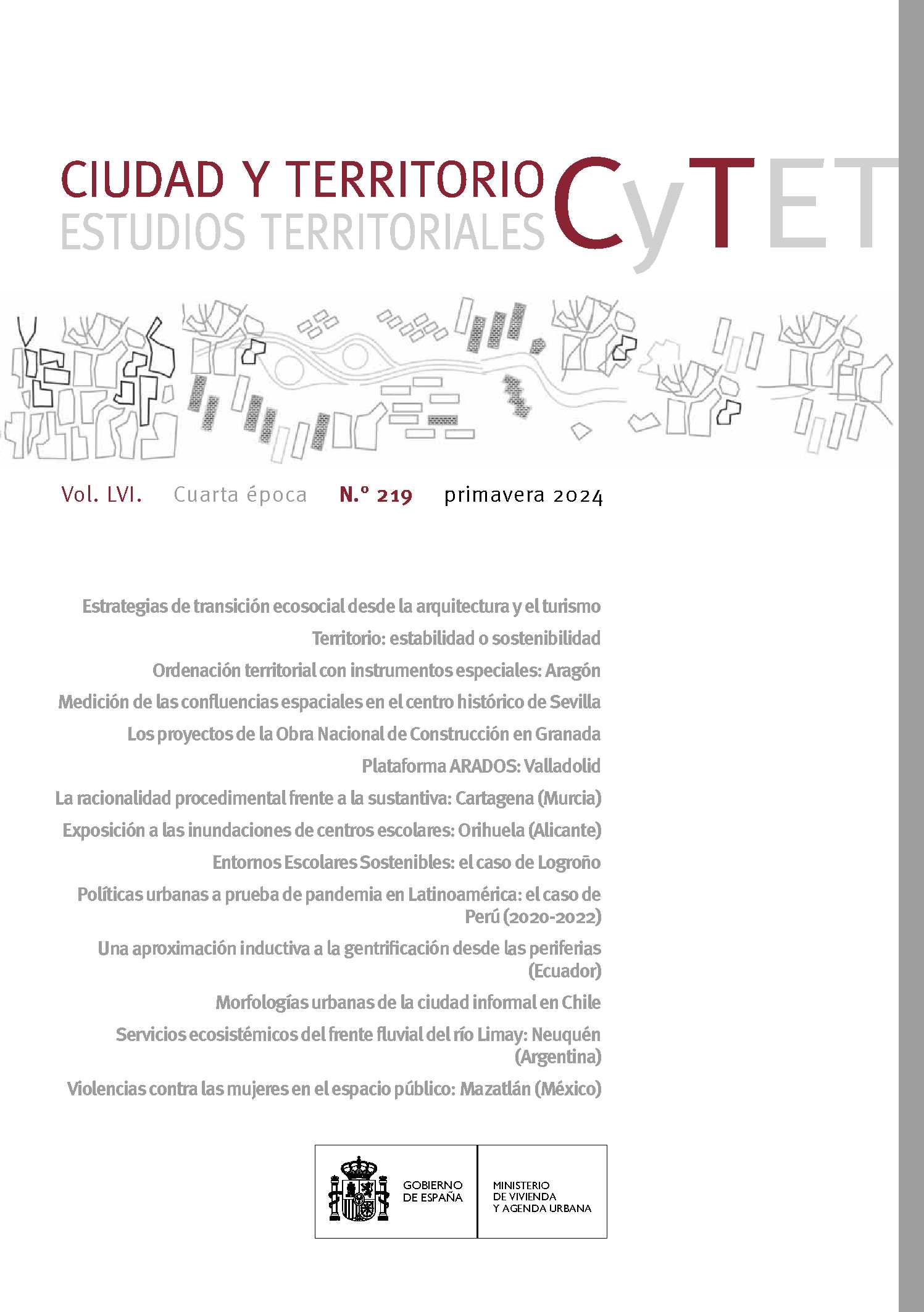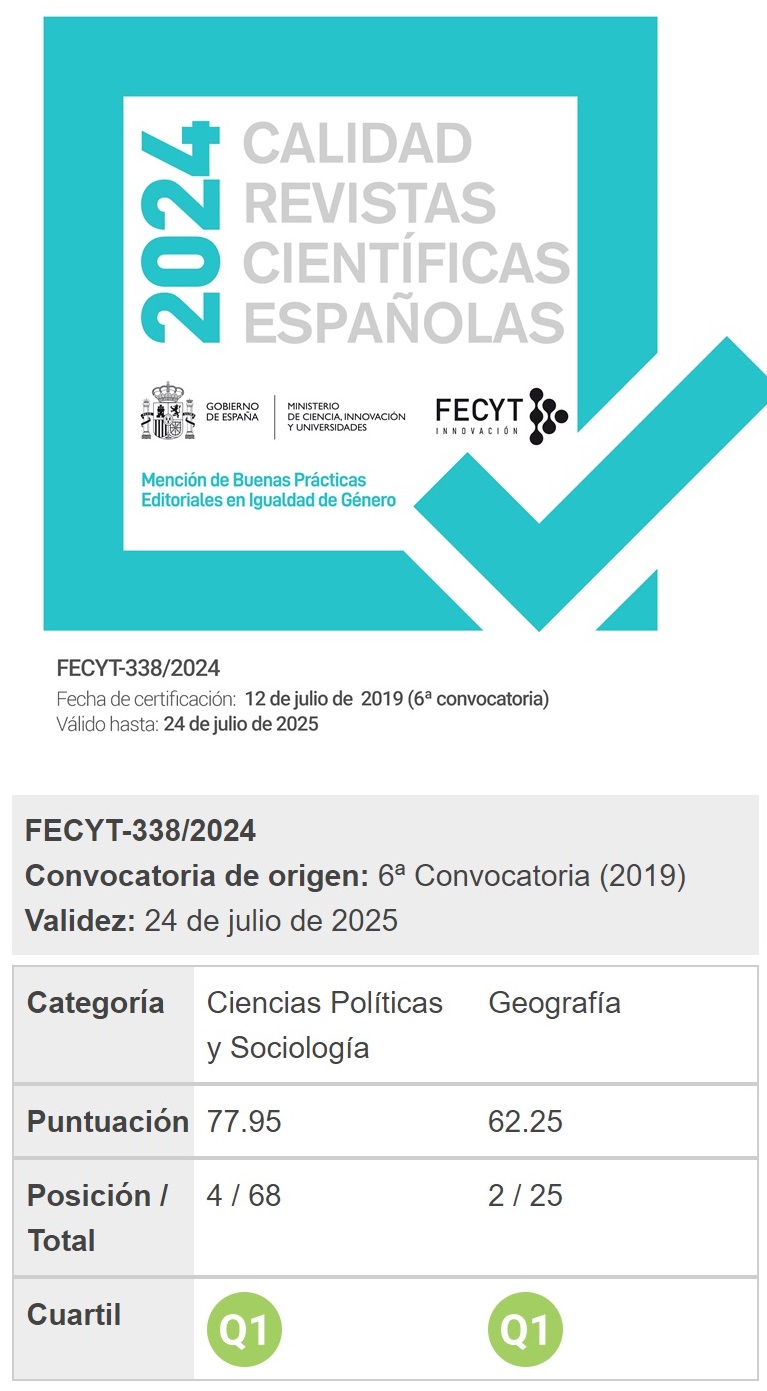Morfologías urbanas de la ciudad informal: lógicas y patrones espaciales en las áreas metropolitanas chilenas
DOI:
https://doi.org/10.37230/CyTET.2024.219.12Palabras clave:
Morfología urbana, Producción informal del hábitat, Asentamientos informales, Informalidad urbana, ChileResumen
La producción social del hábitat genera condiciones morfológicas que obedecen a una lógica incremental, adaptativa y de micro-escala. Analizar, clasificar y comprender la morfología urbana de los asentamientos informales es clave para entender cómo opera la producción informal en las ciudades del Sur Global. A través de una categorización de la morfología urbana que incluye distintas mixturas de formalidad e informalidad, se mapean y analizan patrones espaciales de urbanización informal en seis áreas metropolitanas de Chile: Gran Iquique, Antofagasta, Gran Valparaíso, Santiago, Gran Concepción y Temuco. La investigación avanza en revelar las lógicas y patrones espaciales de la urbanización espontánea, demostrando que la producción informal juega un rol importante en los actuales procesos de urbanización de las ciudades chilenas. Las áreas de vivienda social representan el patrón morfológico dominante, el cual ha emergido a través de adiciones y transformaciones incrementales. Esto plantea una compleja intersección entre las políticas de vivienda neoliberales y la transformación del hábitat a través de prácticas informales.
Descargas
Citas
ARELLANO, N. (2005): Historia local del acceso popular al suelo. El caso de la ciudad Viña del Mar. Revista INVI, 20(54), 56-84.
AZÓCAR, G. & HENRÍQUEZ, C. & VALENZUELA, C. & ROMERO, H. (2008): Tendencias sociodemográficas y segregación socioespacial en Los Ángeles, Chile. Revista de geografía Norte Grande, (41), 103-128. https://doi.org/10.4067/S0718-34022008000300006
BASILE, P. & EHLENZ, M. M. (2020): Examining responses to informality in the Global South: A framework for community land trusts and informal settlements. Habitat international, 96, 102108. https://doi.org/10.1016/j.habitatint.2019.102108
BRAIN, I. & PRIETO, J. J. & SABATINI, F. (2010): Vivir en Campamentos: ¿Camino hacia la vivienda formal o estrategia de localización para enfrentar la vulnerabilidad? EURE, 36(109), 111-141. http://dx.doi.org/10.4067/S0250-71612010000300005
CASTRO, C. P. & IBARRA, I. & LUKAS, M. & ORTIZ, J. & SARMIENTO, J. P. (2015): Disaster risk construction in the progressive consolidation of informal settlements: Iquique and Puerto Montt (Chile) case studies. International Journal of Disaster Risk Reduction, 13, 109-127. https://doi.org/10.1016/j.ijdrr.2015.05.001
CELHAY, P. A. & GIL, D. (2020): The function and credibility of urban slums: Evidence on informal settlements and affordable housing in Chile. Cities, 99, 102605. https://doi.org/10.1016/j.cities.2020.102605
COBOS, E. P. (2014): La ciudad capitalista en el patrón neoliberal de acumulación en América Latina. Cadernos metrópole, 16, 37-60. https://doi.org/10.1590/2236-9996.2014-3102
CONTRERAS, Y. & NEIVILLE, L. & GONZÁLEZ, R. (2019): In-formality in access to housing for Latin American migrants: A case study of an intermediate Chilean city. International Journal of Housing Policy, 19, 411-435. https://doi.org/10.1080/19491247.2019.1627841
DAHER, A. (2015): Cluster minero sin cluster social: Antofagasta-Chile. Revista de Urbanismo, 33, 26-36. https://doi.org/10.5354/0717-5051.2015.37964
DAVIS, M. (2007): Planet of slums. UK, London, Verso.
DE RAMÓN, A. (1990): La población informal. Poblamiento de la periferia de Santiago de Chile. 1920-1970. Revista EURE, XVII(50), 5-17.
DE SOLÁ-MORALES, M., (1997): Las formas de crecimiento urbano. Barcelona, España, Ediciones UPC.
DOVEY, K. (2014): “Incremental Urbanism: The emergence of informal settlements”. En T. HAAS & K. OLSSON & (Eds.): Emergent Urbanis: Urban planning and design in times of structural and systemic change (pp. 45-54). Routledge.
DOVEY, K. & KAMALIPOUR, H. (2018): “Informal/Formal Morphologies”. En K. DOVEY & E. PAFKA & M. RISTIC (Eds.): Mapping urbanities (pp. 223-248). Routledge.
DOVEY, K. & KING, R. (2011): Forms of Informality: Morphology and Visibility of Informal Settlements. Built Environment, 37(1), 11-29. http://www.jstor.org/stable/23289768
DOVEY, K. & VAN OOSTRUM, M. & CHATTERJEE, I. & SHAFIQUE, T. (2020): Towards a morphogenesis of informal settlements. Habitat International, 104, 102240. https://doi.org/10.1016/j.habitatint.2020.102240
GARÍN, A. & SALVO, S. & BRAVO, G. (2009): Segregación residencial y políticas de vivienda en Temuco: 1992-2002. Revista de geografía Norte Grande, 44. https://doi.org/10.4067/S0718-34022009000300006
GILBERT, A. (2002): Power, Ideology and the Washington Consensus: The Development and Spread of Chilean Housing Policy. Housing Studies, 17(2), 305-324. https://doi.org/10.1080/02673030220123243
HERNÁNDEZ, F. & KELLET, P. & ALLEN, L. K. (2010): Rethinking the informal city: Critical perspectives from Latin America. Berghahn Books
HIDALGO, R. (2004): “La vivienda social en Santiago de Chile en la segunda mitad del siglo XX: Actores relevantes y tendencias espaciales”. En C. DE MATTOS & M. E. DUCCI & A. RODRÍGUEZ & G. YÁÑEZ WARNER (Eds.): Santiago en la globalización ¿Una nueva ciudad? (pp. 219-241). Ediciones Sur.
HIDALGO, R. & ZUNINO, H. & ÁLVAREZ, L. (2007): El emplazamiento periférico de la vivienda social en el área metropolitana de Santiago de Chile: Consecuencias socio espaciales y sugerencias para modificar los criterios actuales de localización. Scripta Nova. Revista Electrónica de Geografía y Ciencias Sociales, XI(245), Art. 27.
IMILÁN, W. & OSTERLING, E. & MANSILLA, P. & JIRÓN, P. (2020): El campamento en relación con la ciudad: Informalidad y movilidades residenciales de habitantes de Alto Hospicio. Revista INVI, 35(99), 57-80. https://doi.org/10.4067/S0718-83582020000200057
JIRÓN, P. (2010): “The evolution of informal settlements in Chile: Improving housing conditions in cities”. En F. Hernández & P. KELLET & L. K. ALLEN (Eds.): Rethinking the informal City (pp. 70-90). Berghahn.
JONES, P. (2020): Distance and proximity matters: Understanding housing transformation through micro-morphology in informal settlements. International Journal of Housing Policy, 21(2), 169-195. https://doi.org/10.1080/19491247.2020.1818052
KAMALIPOUR, H. (2020): Improvising Places: the Fluidity of Space in Informal Settlements. Sustainability, 12(6), 2293. https://doi.org/10.3390/su12062293
KAMALIPOUR, H. & DOVEY, K. (2018): “Incremental Urbanisms”. En K. DOVEY & E. PAFKA & M. RISTIC (Eds.): Mapping urbanities (pp. 249-267). Routledge.
KAMALIPOUR, H. & DOVEY, K. (2020): Incremental production of urban space: A typology of informal design. Habitat International, 98, 102133. https://doi.org/10.1016/j.habitatint.2020.102133
KAMALIPOUR, H. & PEIMANI, N. (2019): Towards an Informal Turn in the Built Environment Education: Informality and Urban Design Pedagogy. Sustainability, 11(15), 4163. https://doi.org/10.3390/su11154163
KUFFER, M. & PFEFFER, K. & SLIUZAS, R. (2016): Slums from Space- 15 Years of Slum Mapping Using Remote Sensing. Remote Sensing, 8(6), 455. https://doi.org/10.3390/rs8060455
KUSNETZOFF, F. (1987): Urban and Housing Policies under Chile’s Military Dictatorship 1973-1985. Latin American Perspectives, 14(2), 157-186. https://doi.org/10.1177/0094582X8701400203
LIZARRALDE, G. (2015): The invisible houses: Rethinking and designing low-cost housing in developing countries. Routledge.
LÓPEZ MORALES, E. & FLORES PINEDA, P. & OROZCO RAMOS, H. (2016): Inmigrantes en campamentos en Chile: ¿mecanismo de integración o efecto de exclusión? Revista INVI, 33(94), 161-187. https://doi.org/10.4067/S0718-83582018000300161
MARSHALL, S. (2009): Cities, design and evolution. Routledge.
MCCARTNEY, S. & KRISHNAMURTHY, S. (2018): Neglected? Strengthening the Morphological Study of Informal Settlements. Sage Open, 8(1). https://doi.org/10.1177/2158244018760375
MINISTERIO DE VIVIENDA Y URBANISMO, MINVU (2018): Catastro de Campamentos. http://www.minvu.cl/catastro-de-campamentos/
MORALES, R. & BESOAIN, C. & SOTO, A. & PINTO, L. & HIDALGO, K. & FERNÁNDEZ, I. & BERNAL SANTIBÁÑEZ, V. (2017): Back to the settlement: Resistance and melancholy on the boarders of the formal city. Revista INVI, 32(90), 51-75. https://doi.org/10.4067/S0718-83582017000200051
MOTTELSON, J. & VERANDI, A. (2020): A Fine-Grain Multi-Indicator Analysis of the Urban Form of Five Informal Settlements in East Africa. Urban Science, 4(3), 31. https://doi.org/10.3390/urbansci4030031
NAPADENSKY, A. (2016): Centros tradicionales, nuevas centralidades y descentralización en metrópolis intermedias latinoamericanas. Caso del Gran Concepción, Chile. Cuaderno urbano: espacio, cultura, Sociedad, (21), 29-56.
O’BRIEN, D. & CARRASCO, S. (2020): Contested incrementalism: Elemental’s Quinta Monroy settlement fifteen years on. Frontiers of Architectural Research, 10(2), 263-273. https://doi.org/10.1016/j.foar.2020.11.002
O’BRIEN, D. & DOVEY, K. (2020): Incremental housing: Harnessing informality at Villa Verde. International Journal of Architectural Research, 14(3), 345-358. https://doi.org/10.1108/ARCH-10-2019-0237
OJEDA, L. & BACIGALUPE, G. & PINO, A. (2018): Co-production after an urban forest fire: Post-disaster reconstruction of an informal settlement in Chile. Environment and Urbanization, 30(2), 537-556. https://doi.org/10.1177/0956247818790731
O’BRIEN, D. & RODRIGUEZ, J. C. & MANSILLA, P. & PINO, A. (2020): El acceso al agua en asentamientos informales. El caso de Valparaíso, Chile. Bitácora Urbano Territorial, 30(1), 151-165. https://doi.org/10.15446/bitacora.v30n1.72205
OLIVEIRA, V. (2016): Urban Morphology. Springer.
PINO, A. & OJEDA, L. (2013): Ciudad y hábitat informal: Las tomas de terreno y la autoconstrucción en las quebradas de Valparaíso. Revista INVI, 28(78), 109-140. http://dx.doi.org/10.4067/S0718-83582013000200004
ROBINSON, J. (2002): Global and World Cities: A view from off the map. International Journal of Urban and Regional Research, 26(3), 531-554. https://doi.org/10.1111/1468-2427.00397
RODRÍGUEZ, A. & SUGRANYES, A. (2004): El problema de vivienda de los “con techo”. EURE (Santiago), 30(91), 53-65. https://doi.org/10.4067/S0250-71612004009100004
ROY, A. (2005): Urban informality: Toward an epistemology of planning. Journal of the American Planning Association, 71(2), 147-158. https://doi.org/10.1080/01944360508976689
ROY, A. (2015): “Urban Informality: The Production and Regulation of Space”. En J. D. WRIGHT (Ed.): International Encyclopedia of the Social & Behavioral Sciences (pp. 818-822). Elseiver.
SABATINI, F. (2000): Reforma de los mercados de suelo en Santiago, Chile: Efectos sobre los precios de la tierra y la segregación residencial. EURE (Santiago), 26(77), 49-80. https://doi.org/10.4067/S0250-71612000007700003
SABATINI, F. & CÁCERES, G. & CERDA, J. (2001): Segregación residencial en las principales ciudades chilenas: Tendencias de las tres últimas décadas y posibles cursos de acción. EURE (Santiago), 27(82), 21-42. https://doi.org/10.4067/S0250-71612001008200002
SEVILLA-BUITRAGO, Á. (2023): Fetichismo morfológico: informalidad y estigmatización en la historia del urbanismo. Ciudad y Territorio Estudios Territoriales, 55(215), 07-26. https://doi.org/10.37230/CyTET.2023.215.1
TAUBENBÖCK, H. & KRAFF, N. J. & WURM, M. (2018): The morphology of the Arrival City- A global categorization based on literature surveys and remotely sensed data. Applied Geography, 92, 150-167. https://doi.org/10.1016/j.apgeog.2018.02.002
TECHO-CHILE (2021): Catastro Nacional de Campamentos 2020-2021. CES Chile. https://ceschile.org/catastro/
UN (2018): World Urbanization Prospects. UN, Department of Economic and Social Affairs.
UN HABITAT (2015): World Cities Report 2016. UN-Habitat.
UN HABITAT (2016): Slum Almanac 2015-2016. UN-Habitat.
VERGARA PERUCICH, J. F. & ARIAS LOYOLA, M. (2019): Bread for advancing the right to the city: Academia, grassroots groups and first cooperative bakery in a Chilean informal settlement. Environment and Urbanization, 31(2), 533-551. https://doi.org/10.1177/0956247819866156
ZHANG, J. & SHUANG CHEN, S. & GAO, Q. & SHEN, Q. & KMIREI, I. A. & MAPUNDA, D. W. (2020): Morphological characteristics of informal settlements and strategic suggestion for urban sustainable development in Tanzania: Dar es Salaam, Mwanza, and Kigoma. Sustainability, 12(9), 3807. https://doi.org/10.3390/su12093807
Publicado
Cómo citar
Número
Sección
Licencia
Derechos de autor 2023 Víctor Alegría-Corona

Esta obra está bajo una licencia internacional Creative Commons Atribución-NoComercial-SinDerivadas 4.0.
Sin perjuicio de lo dispuesto en la legislación vigente sobre Propiedad Intelectual, y conforme a la misma, el/la los/las autor/a/es/as que publiquen en CyTET cede/n a título gratuito, de modo no exclusivo y sin límite temporal al Ministerio de Transportes, Movilidad y Agenda Urbana los derechos para difundir, reproducir, comunicar y distribuir en cualquier formato actual o futuro, en papel o electrónico, la versión original o derivada de su obra bajo licencia de Creative Commons Reconocimiento-NoComercial-SinObraDerivada 4.0 Internacional (CC BY-NC-ND 4.0), así como para incluir o ceder a terceros la inclusión de su contenido en índices, repositorios y bases de datos nacionales e internacionales, con referencia y reconocimiento en todo caso de la autoría del mismo.
Además, al realizar el envío, el/la los/las autor/a/es/as declara/n que se trata de un trabajo original en el que se reconocen las fuentes que han sido utilizadas en su estudio, comprometiéndose a respetar la evidencia científica y a no modificar los datos originales para verificar o refutar una hipótesis de partida; que el contenido esencial del mismo no ha sido publicado previamente ni se publicará en ninguna otra obra o revista mientras esté en proceso de evaluación en la revista CyTET; y que no se ha remitido simultáneamente a otra publicación.
Los autores deben firmar un Formulario de Cesión de Derechos, que les será enviado desde la Secretaría de CyTET una vez se acepte su artículo para ser publicado.
Con el objetivo de favorecer la difusión del conocimiento, CyTET se adhiere al movimiento de revistas de Open Access (OA) y entrega la totalidad de sus contenidos a diversos índices, repositorios y bases de datos nacionales e internacionales bajo este protocolo; por tanto, la remisión de un trabajo para ser publicado en la revista presupone la aceptación explícita por parte del autor/a de este método de distribución.
Se anima a las/os autoras/es a reproducir y alojar sus trabajos publicados en CyTET en repositorios institucionales, páginas web, etc. con la intención de contribuir a la mejora de la transferencia del conocimiento y de la citación de dichos trabajos.








 Enlace a CyTET en Linkedin
Enlace a CyTET en Linkedin